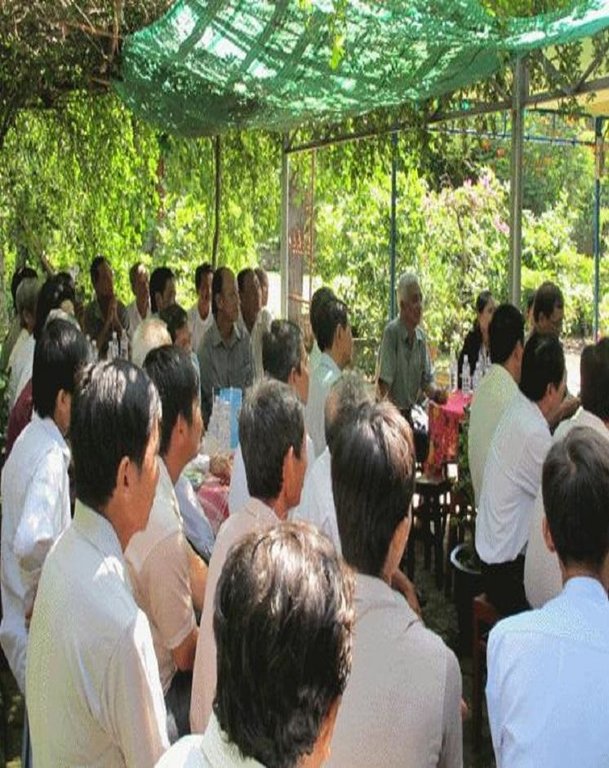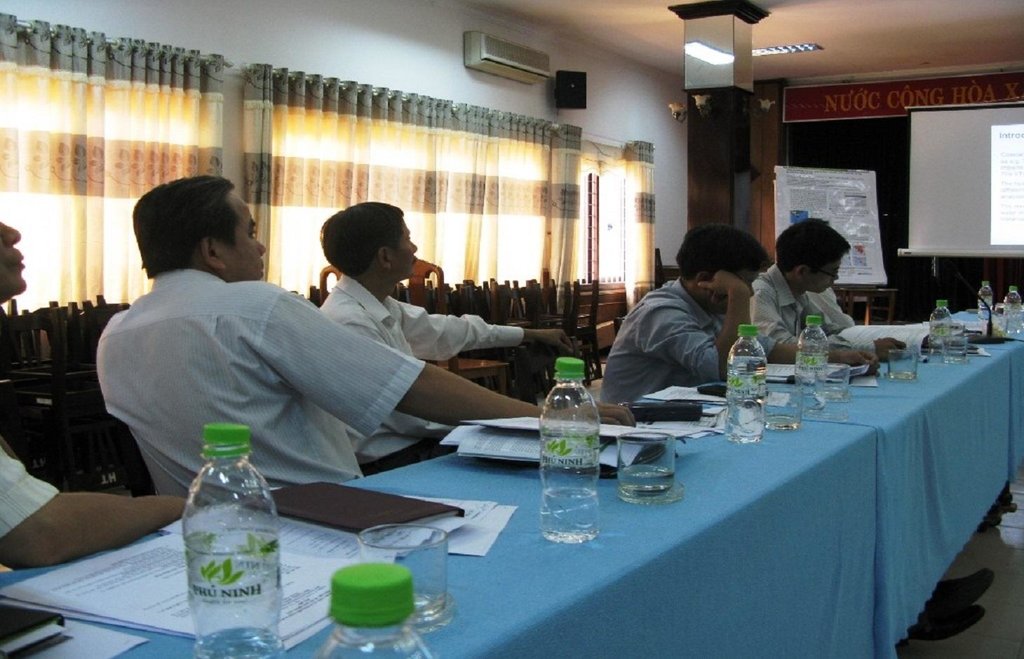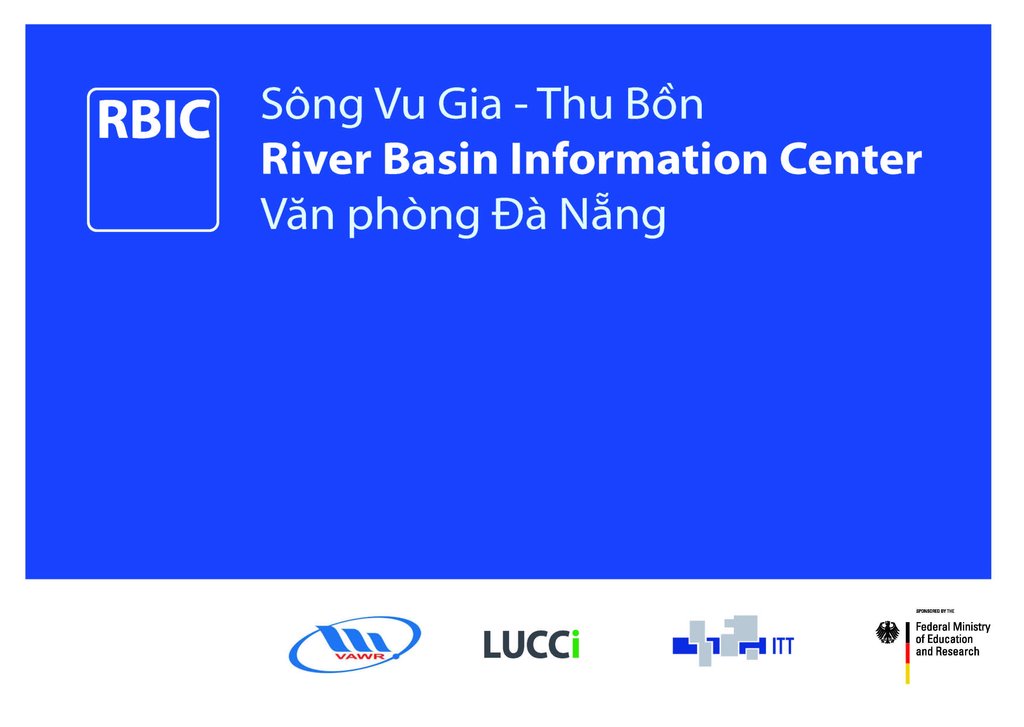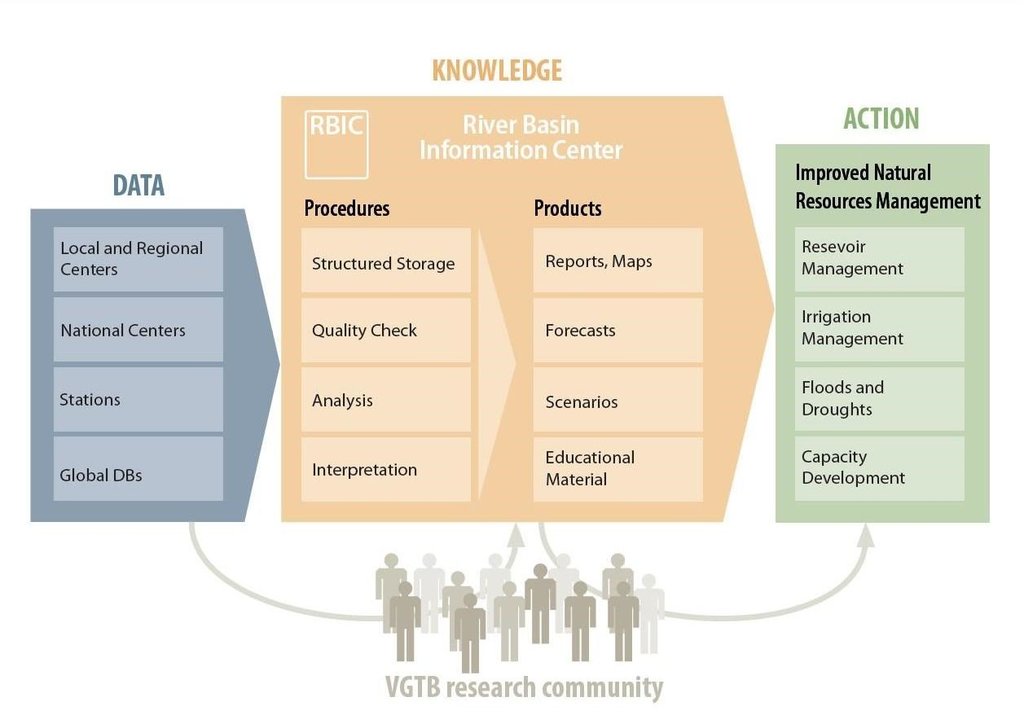Vu Gia Thu Bon River Basin Information Centre [Viet Nam]
- Creation:
- Update:
- Compiler: Justyna Sycz
- Editor: –
- Reviewer: Fabian Ottiger
Trung tâm thông tin lưu vực sông VGTB (Vietnamese)
approaches_2536 - Viet Nam
View sections
Expand all Collapse all1. General information
1.2 Contact details of resource persons and institutions involved in the assessment and documentation of the Approach
SLM specialist:
Nauditt Alexandra
alexandra.nauditt@th-koeln.de
University of Applied Science, TH Köln
Germany
SLM specialist:
Ribbe Lars
lars.ribbe@th-koeln.de
University of Applied Science, TH Köln
Germany
SLM specialist:
Nguyen Phong
phongicd@gmail.com
Vietnam Academy for Water Resources
Hanoi
Viet Nam
Name of the institution(s) which facilitated the documentation/ evaluation of the Approach (if relevant)
University of Applied Science, TH Köln (TH Köln) - GermanyName of the institution(s) which facilitated the documentation/ evaluation of the Approach (if relevant)
Vietnam Academy for Water Resources (VAWR) - Viet Nam1.3 Conditions regarding the use of data documented through WOCAT
When were the data compiled (in the field)?
27/07/2015
The compiler and key resource person(s) accept the conditions regarding the use of data documented through WOCAT:
Yes
1.4 Reference(s) to Questionnaire(s) on SLM Technologies
2. Description of the SLM Approach
2.1 Short description of the Approach
The VGTB River Basin Information Centre (RBIC) offers decision support tools for stakeholders and aims at providing comprehensive information and consulting services to the water and land users according to their demands.
2.2 Detailed description of the Approach
Detailed description of the Approach:
Aims / objectives: Sufficient and sustainable water resource management at river basin scale can only be achieved if it is based on dialogue between all relevant stakeholders, and supported by adequate data. It follows then, that a robust system of monitoring, evaluation, reporting and communication is needed. The lack of appropriate management strategies which would bring these tools together has been underlined by stakeholders, and observed by researchers, involved in the research project LUCCi - Land Use and Climate Change Interactions in the VGTB River Basin. In order to offer a comprehensive decision-making support system, based on scientific knowledge and research results, the Institute for Technology and Resources Management (ITT, TH Köln, Germany) in cooperation with the Vietnam Academy for Water Resources (VAWR, Hanoi, Vietnam) established the VGTB River Basin Information Centre in Da Nang. The overall objective of RBIC is to support efficient and sustainable water and land use. The support provided for the implementation of the water saving technology for paddy systems is one of the services offered by the centre.
Methods: The VGTB RBIC is an independent, local institution administrated by the German and Vietnamese coordinators of LUCCi, financed by project sources and located at the Central Department of the Vietnam Academy of Water Resources in Da Nang. As a scientific organization, the VGTB RBIC provides the advantages of impartiality, a detailed knowledge base and a broad interdisciplinary perspective. Through different dissemination activities, such as visits to relevant institutions, information material (brochures, flyers in Vietnamese) as well as training courses and capacity building measures, the relevant stakeholders are well-informed about the activities of the Information Centre. On demand, the following products and services are provided in the VGTB-RBIC: (a) Thematic maps on land use, hydrology and river basin development; (b) A comprehensive database of the VGTB river basin (VGTB RBIS - River Basin Information System, open source) (c) VGTB State of the Basin Report as a decision-support instrument: the report was prepared by the LUCCi research team and provides relevant information on climatic, environmental and socioeconomic data and trends; (d) Hydro-meteorological, hydrograph and salinity data; (e) Flood and drought risk assessment; (f) Scenarios and modelling (reservoir operation, salinity intrusion, irrigation management scenarios); (g) Organization of meetings and discussions on key issues of the development of the VGTB; (f) Training and capacity building services related to the demands of stakeholders.
Role of stakeholders: Thus a heterogeneous stakeholder platform has been established in the case study region that includes scientific institutions, policy makers, public administration representatives as well as private sector companies. It is clear that the major problems of the VGTB River Basin can be only addressed, and adequate solutions identified, if based on active cross-sectoral stakeholder participation. Therefore, the interaction among stakeholders and RBIC plays a key role: the services are offered for the stakeholders, and stakeholder feedback is the basis for providing adequate information services and conducting applied based research.
2.3 Photos of the Approach
2.5 Country/ region/ locations where the Approach has been applied
Country:
Viet Nam
Region/ State/ Province:
Da Nang
Further specification of location:
Central Vietnam
2.6 Dates of initiation and termination of the Approach
Indicate year of initiation:
2013
Year of termination (if Approach is no longer applied):
2015
2.7 Type of Approach
- project/ programme based
2.8 Main aims/ objectives of the Approach
The Approach focused mainly on other activities than SLM (Water management, agriculture, irrigation, water availability: support the local water users in the implementation of adequate water management strategies)
1. Establish a communication platform to discuss water and land use related problems, and create transparency among water users.
2. Support and foster the science-policy-society dialogue offering a cross-sectoral neutral space for discussion, consulting and capacity building for all stakeholders and water users (farmers, decision-makers, public institutions, private sector companies).
3. Provide a comprehensive information service and decision support system to stakeholders according to their demands. The following specific products and services are provided by the VGTB-RBIC: Thematic maps on land uses, hydrology and river basin development • Comprehensive database of the VGTB river basin (VGTB RBIS - River Basin Information System, open source) • VGTB State of the Basin Report as a decision support instrument: the report was prepared by the LUCCi research team and provides relevant information on climatic, environmental and socioeconomic data and trends • Hydro-meteorological, hydrograph and salinity data • Flood and drought risk assessment • Scenarios and modelling (reservoir operation, salinity intrusion, irrigation management scenarios) • Organization of meetings and discussions on key issues of the development of the VGTB • Training and capacity building services related to the demands of stakeholders.
The SLM Approach addressed the following problems: The lack of communication between the relevant institutions and water users, the demand for comprehensive decision-support instruments, difficulties with data availability - typically distributed and available at different institutions, as well as conflicts over resource use, were the main problems addressed by the approach. The conflicts caused by the rapid expansion of hydropower since 2008 in the VGTB river basin have especially demonstrated the inadequate participation of local stakeholders in planning processes. Hydropower development has adverse effects on downstream water availability, especially during the dry season, affecting drinking water supply and irrigation.
2.9 Conditions enabling or hindering implementation of the Technology/ Technologies applied under the Approach
institutional setting
- hindering
Lack of communication between the institutions and inadequate stakeholder involvement in the decision making process.
Treatment through the SLM Approach: VGTB RBIC offers a cross sectoral communication platform and bring together all relevant stakeholders: organization of workshops and meetings as well as visits to the relevant institutions.
knowledge about SLM, access to technical support
- hindering
A robust system of monitoring system was missed in the region: hydro-meteorological data, monitoring of water quantity.
Treatment through the SLM Approach: A monitoring network has been established as part of the LUCCi project.
other
- hindering
Lack of information about the river basin in order to ensure an adequate decision making.
Treatment through the SLM Approach: A “State of the Basin Report” including all available data and information about the river basin has been elaborated (climatic, environmental, hydrological, land use and socioeconomic data and trends); River Basin Information System: Comprehensive data base of the VGTB river basin through the open source VGTB River Basin Information System.
3. Participation and roles of stakeholders involved
3.1 Stakeholders involved in the Approach and their roles
- researchers
National and international researchers involved in the LUCCi project
- NGO
Authorities of a Water Management Unit (WMU)
- national government (planners, decision-makers)
Regional relevant institutions (DONRE, MARD, PPC Quang Nam)
- international organization
3.2 Involvement of local land users/ local communities in the different phases of the Approach
| Involvement of local land users/ local communities | Specify who was involved and describe activities | |
|---|---|---|
| initiation/ motivation | passive | Stakeholder analysis (including of all ineterested groups) |
| planning | passive | Local and regional decision makers are involved: workshops, discussions and surveys in order to collect relevant socio-economic and land use data, identify research demand and challenges |
| implementation | external support | Land user decide on whether and which technologies they want to implement. |
| monitoring/ evaluation | none | |
| Research | interactive | Land users provide relevant information and data on their farms (size, yields) for research purposes. 'Aims/Objectives” elaborated and prepared for the stakeholders by Vietnamese and international researchers based on scientific results and data from land users. |
3.3 Flow chart (if available)
Description:
The services of the VGTB Info-Centre are provided by a team of researchers and experts from national and international institutions. The services and products are offered to the following target groups: Public administration and decision-makers in Central Vietnam, Land and water users, researchers, and private sector companies in the field of water and land management (e.g. irrigation, hydropower construction)
Interaction and communication between the groups involved:
- based on stakeholders and target groups’ feedback, the centre can provide services suited to the needs of the regional institutions, considering current socioeconomic development and environmental changes in the river basin
- the centre provides a communication platform for the target groups involved from different sectors: private companies, public administration, researchers, land and water users.
3.4 Decision-making on the selection of SLM Technology/ Technologies
Specify who decided on the selection of the Technology/ Technologies to be implemented:
- mainly SLM specialists, following consultation with land users
Explain:
Decisions on the method of implementing the SLM Technology were made by mainly by SLM specialists with consultation of land users
4. Technical support, capacity building, and knowledge management
4.1 Capacity building/ training
Was training provided to land users/ other stakeholders?
Yes
- decision makers/ experts/ local scientists
Form of training:
- demonstration areas
Subjects covered:
key aspects of an integrated river basin management (monitoring, data management and hydrological modelling); current situation, development and challenges in the VGTB river basin; training on adequate tools and technologies (alternative irrigation strategies for paddy fields: reuse of return flow)
4.2 Advisory service
Do land users have access to an advisory service?
Yes
Specify whether advisory service is provided:
- at permanent centres
Describe/ comments:
Name of method used for advisory service: River Basin Information Center - RBIC; Key elements: Stakeholder Workshops, Trainings on alternative irrigation strategies for paddy fields: reuse of return flow
Advisory service is very adequate to ensure the continuation of land conservation activities; Researchers (VAWR): can offer trainings and conduct dissemination activities; Local institutions (e.g. People's Committee of Quang Nam Province): training, dissemination activities, financial support
4.3 Institution strengthening (organizational development)
Have institutions been established or strengthened through the Approach?
- yes, greatly
Specify the level(s) at which institutions have been strengthened or established:
- local
Specify type of support:
- capacity building/ training
- research
Give further details:
Training for decision makers and professionals; Research: hydrological modeling
4.4 Monitoring and evaluation
Is monitoring and evaluation part of the Approach?
Yes
Comments:
management of Approach aspects were ad hoc monitored by project staff through observations
management of Approach aspects were ad hoc monitored by project staff through measurements
There were several changes in the Approach as a result of monitoring and evaluation: The approach was based on the stakeholder-research interactions. The approach objectives and methodology was adapted to the local conditions and challenges.
There were no changes in the Technology as a result of monitoring and evaluation
4.5 Research
Was research part of the Approach?
Yes
Specify topics:
- sociology
- technology
- hydrological modeling
Give further details and indicate who did the research:
The implementation of return flow from paddy fields as alternative irrigation technology under local conditions was performed under the framework of LUCCi project (ITT).
Research was carried out both on station and on-farm
5. Financing and external material support
5.1 Annual budget for the SLM component of the Approach
If precise annual budget is not known, indicate range:
- < 2,000
Comments (e.g. main sources of funding/ major donors):
Approach costs were met by the following donors: international (International (German Federal Ministry of Education and Research, BMBF)): 70.0%; government (National (Vietnam Academy for Water Resources, VAWR) ): 30.0%
5.4 Credit
Was credit provided under the Approach for SLM activities?
No
6. Impact analysis and concluding statements
6.1 Impacts of the Approach
Did the Approach help land users to implement and maintain SLM Technologies?
- No
- Yes, little
- Yes, moderately
- Yes, greatly
Decreased water use;efficient resource management
Did the Approach empower socially and economically disadvantaged groups?
- No
- Yes, little
- Yes, moderately
- Yes, greatly
Did other land users / projects adopt the Approach?
- No
- Yes, little
- Yes, moderately
- Yes, greatly
Did the Approach lead to improved livelihoods / human well-being?
- No
- Yes, little
- Yes, moderately
- Yes, greatly
6.2 Main motivation of land users to implement SLM
- increased production
- well-being and livelihoods improvement
Increase water use efficiency
6.3 Sustainability of Approach activities
Can the land users sustain what has been implemented through the Approach (without external support)?
- yes
6.4 Strengths/ advantages of the Approach
| Strengths/ advantages/ opportunities in the compiler’s or other key resource person’s view |
|---|
| The approach is managed by researchers. This has the advantages of impartiality, a detailed knowledge base and a broad interdisciplinary perspective. |
| Adaptability to stakeholders needs. (How to sustain/ enhance this strength: Strong interaction between the management of the VGTB RBIC and regional stakeholders is necessary: organize regular meetings and workshops; Stakeholders regularly inform the centre about their information requirements.) |
|
Monitoring, evaluation, reporting and communication are integrated, summarized and carried out by one institution. |
6.5 Weaknesses/ disadvantages of the Approach and ways of overcoming them
| Weaknesses/ disadvantages/ risks in the land user’s view | How can they be overcome? |
|---|---|
| It needs long-term commitment from research, from extension, and from the government to support such a service for the benefit of all people and the environment. |
| Weaknesses/ disadvantages/ risks in the compiler’s or other key resource person’s view | How can they be overcome? |
|---|---|
|
The VGTB RBIC is a new institution, unknown to the local stakeholders. |
Provide dissemination activities and trainings in order to explain the decision making process and the role of VGTB RBIC as support instrument. |
|
The approach was developed as part of a research project. There is the risk, that the scale of activities and services will be reduced after the end of the project duration. |
Try to obtain financial resources by the local and public institutions in order to develop and manage the center after the end of the project. |
7. References and links
7.1 Methods/ sources of information
- field visits, field surveys
- interviews with land users
7.2 References to available publications
Title, author, year, ISBN:
Ribbe, L., Viet, Quoc Trinh, ABM Firoz, Anh Thu Nguyen, Uyen Nguyen, Alexandra Nauditt (2016) Integrated River Basin Management in the Vu Gia Thu Bon Basin
Available from where? Costs?
Nauditt, Ribbe (editors) Land Use and Climate Change Interaction in Central Vietnam, Springer Book Series Water Resources Management and Development
Links and modules
Expand all Collapse allLinks
No links
Modules
No modules







